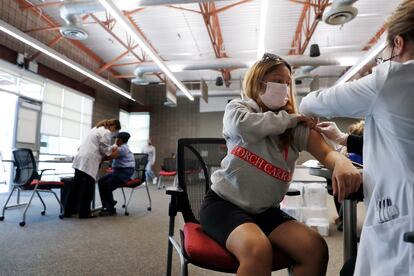Are Covid cases growing in the United States? Things to know for summer
Although deaths from coronavirus have increased across the country, the numbers are not as high as in previous years

Recent data from federal health agencies, especially the Centers for Disease Control and Prevention (CDC), indicates an increase in both emergency room visits and deaths attributed to Covid in several states. According to the latest data released on July 1, emergency department visits are up 23%, an increase that reflects an upward trend seen since early summer. The data points to a resurgence in certain states, including Hawaii and to a lesser extent, Arizona, New Mexico, Florida and Washington.
The percentage of emergency room visits where patients were diagnosed as positive for Covid was 0.9%, according to the latest CDC report, with figures from the week of June 22, the latest available. The data suggests that although the total number of cases may not be overwhelming health systems, the virus continues to circulate and impact communities. This surge comes amid ongoing efforts to manage and mitigate the spread of the virus, despite the availability of vaccines and prior exposure to the virus among a significant portion of the population.
In addition to the increase in emergency room visits, there has also been a 14% jump in Covid-related deaths. While any increase in death rates is concerning, it is essential to contextualize these numbers. Unlike peak periods of the pandemic, especially during the winter months in late 2020 and early 2021, the absolute number of deaths remains lower.
This increase in deaths reflects a percentage increase rather than a return to the alarming mortality rates seen in the past. However, it underscores the continued threat posed by the coronavirus, especially to vulnerable populations such as older adults and those with underlying health conditions.
Why are cases increasing?
Several factors are contributing to the recent increase in Covid cases, emergency room visits and deaths. First, there are new variants, such as the KP.3 and KP.2 strains, and these have caused the disease to spread further. These variants, although not necessarily more severe in symptomatology, can potentially evade immunity acquired from previous infections or vaccines.
Secondly, seasonal variations in Covid transmission patterns have been observed, with warmer months traditionally seeing lower case counts. However, the recent rebound indicates that the dynamics of Covid transmission may not depend solely on environmental factors, but also on behavioral and epidemiological factors. Large crowds of people, a reduction in adherence to preventive measures such as the use of masks, and travel patterns are also contributing factors to the current resurgence observed in multiple states.
What to do?
In response to current epidemiological trends, public health agencies such as the CDC highlight the importance of vaccination and adherence to preventive measures. Vaccination remains a critical tool to reduce severe illness, hospitalizations and deaths from Covid, despite the evolving nature of virus variants. CDC recommends booster doses for eligible individuals to enhance immunity against circulating variants and mitigate the risk of re-entry infections that can lead to severe outcomes.
Key preventive measures for Covid include wearing masks in indoor public spaces and when appropriate physical distancing cannot be maintained; washing your hands frequently with soap and water for at least 20 seconds; use alcohol-based hand sanitizer if water is not available; maintain a physical distance of at least one meter with people who are not from the same household; avoid crowds and poorly ventilated closed spaces, and practice respiratory etiquette when coughing or sneezing, covering your mouth with your elbow or a disposable tissue.
Additionally, health systems are asked to maintain preparedness and capacity to handle potential waves of Covid cases. This includes adequate staffing, availability of medical supplies, and ongoing public health messaging to promote testing, isolation, and quarantine protocols. Enhanced surveillance and data collection efforts are also critical to monitoring virus trends, identifying emerging hotspots, and informing targeted interventions to curb transmission.
Sign up for our weekly newsletter to get more English-language news coverage from EL PAÍS USA Edition
Tu suscripción se está usando en otro dispositivo
¿Quieres añadir otro usuario a tu suscripción?
Si continúas leyendo en este dispositivo, no se podrá leer en el otro.
FlechaTu suscripción se está usando en otro dispositivo y solo puedes acceder a EL PAÍS desde un dispositivo a la vez.
Si quieres compartir tu cuenta, cambia tu suscripción a la modalidad Premium, así podrás añadir otro usuario. Cada uno accederá con su propia cuenta de email, lo que os permitirá personalizar vuestra experiencia en EL PAÍS.
¿Tienes una suscripción de empresa? Accede aquí para contratar más cuentas.
En el caso de no saber quién está usando tu cuenta, te recomendamos cambiar tu contraseña aquí.
Si decides continuar compartiendo tu cuenta, este mensaje se mostrará en tu dispositivo y en el de la otra persona que está usando tu cuenta de forma indefinida, afectando a tu experiencia de lectura. Puedes consultar aquí los términos y condiciones de la suscripción digital.
More information
Archived In
Últimas noticias
Most viewed
- Reinhard Genzel, Nobel laureate in physics: ‘One-minute videos will never give you the truth’
- Oona Chaplin: ‘I told James Cameron that I was living in a treehouse and starting a permaculture project with a friend’
- Pablo Escobar’s hippos: A serious environmental problem, 40 years on
- Chevy Chase, the beloved comedian who was a monster off camera: ‘Not everyone hated him, just the people who’ve worked with him’
- Why we lost the habit of sleeping in two segments and how that changed our sense of time











































